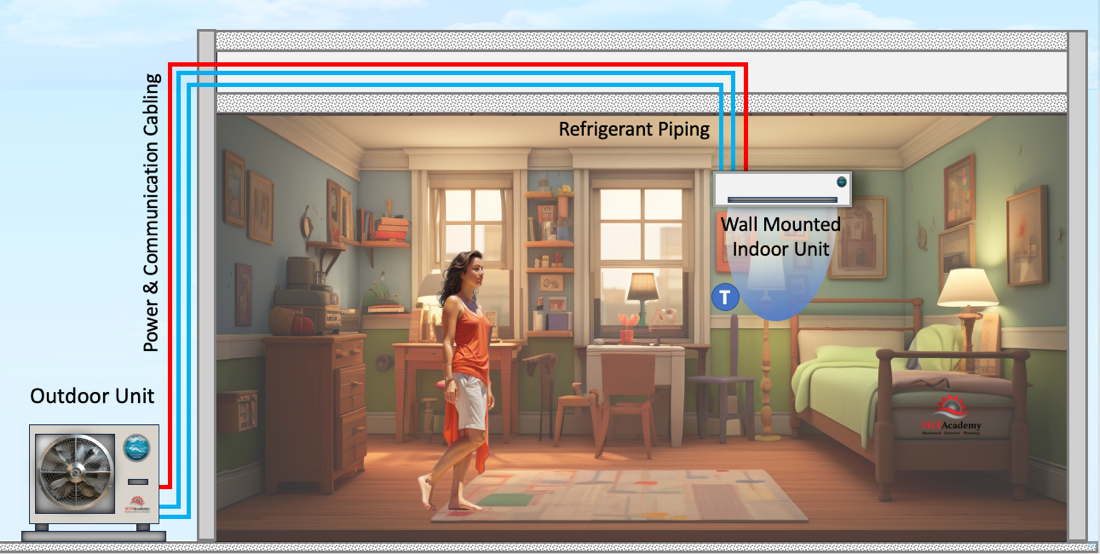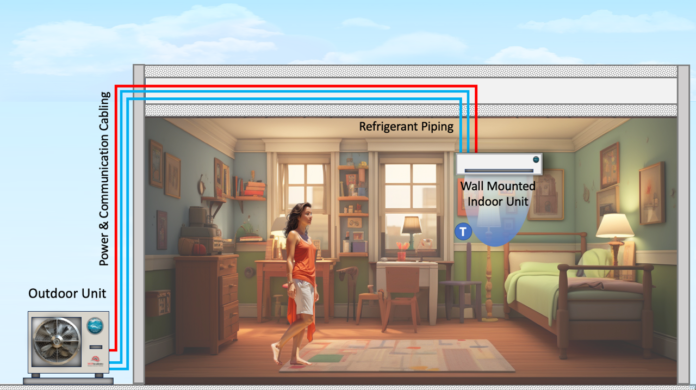We’ll cover some of the advantages and disadvantages to consider when deciding whether to purchase a mini split air conditioner or heat pump. Ductless mini-split system air conditioners offer several advantages over traditional central air conditioning systems, but there are also disadvantages.
Advantages of Mini Split Air Conditioners
We’ll first cover the advantages of mini split AC systems.
Easy Installation
Ductless mini-split systems are relatively easy to install compared to central air conditioning systems. They require minimal construction work since they don’t need air distribution ductwork. The indoor and outdoor units are connected by a small conduit that houses the refrigerant lines, electrical and communication cables, and condensate drain line.
Zoning Capability
One of the significant advantages of mini-split systems is their zoning capability as we demonstrated in our other video (see Mini Split Air Conditioner Single and Multi Zone). Each indoor unit can be controlled independently, allowing you to set different temperatures in various zones or rooms. This feature provides greater control over energy usage and personalized comfort.
Checkout These Mini Split Systems on AmazonEnergy Efficiency
Ductless mini-split systems are highly energy-efficient. Since there are no ducts involved, there is no energy loss due friction within ductwork, or loss to leaks. Becuase you can control each zone separately, you can avoid cooling or heating unoccupied rooms, further reducing energy consumption.
Improved Indoor Air Quality
Traditional central air conditioning systems can accumulate dust, allergens, and other contaminants in the ductwork, which then get distributed throughout the home. Ductless mini-split systems eliminate this issue as they don’t require air distribution ductwork. They typically come with multi-stage filtration systems that help improve indoor air quality.
Flexibility and Design
Ductless mini-split systems offer greater flexibility in terms of installation and design. The indoor units are compact and can be mounted on walls, ceilings, or floors, depending on your preference and space availability. This flexibility makes them suitable for a variety of home configurations, including older homes without existing ductwork.
Quiet Operation
Mini-split systems are designed to operate quietly, with the noisiest components (the compressor and condenser) located outside the building. This ensures minimal noise disturbance indoors, making them ideal for bedrooms, offices, or any area where quiet operation is desired.
Heating Capability
In addition to cooling, many ductless mini-split systems also provide heating capabilities. They can efficiently provide both cooling and heating throughout the year, eliminating the need for separate heating systems and offering year-round comfort. These systems are referred to as heat pumps.
Ok now we’ll cover some of the disadvantages of a mini split air conditioner.

Disadvantages of Ductless Mini Split System
While ductless mini-split system air conditioners have several advantages, they also have some disadvantages to consider:
Upfront Cost
Ductless mini-split systems tend to have a higher upfront cost compared to traditional central air conditioning systems or window units. The cost includes the purchase and installation of both the indoor and outdoor units. However, the long-term energy savings and other benefits may offset this initial investment. The cost can be reduced significantly if heating and cooling is provided for just one or a few rooms instead of the whole house as in a central system.
Professional Installation
While installation is generally easier than installing ductwork, it still requires professional expertise. The refrigerant lines and electrical connections must be correctly installed and properly sized for optimal performance. Improper installation can lead to inefficiencies, reduced lifespan, or even void the warranty. There are some pre-charged refrigerant lines that can simplify the installation if certain requirements are met. See our other video on Single and Multi-Zone Mini Splits.
Aesthetics
While the indoor units of mini-split systems are compact and offer flexibility in placement, they still require visible installation. The wall and floor mounted versions, including the ceiling cassette are all visible to the occupants. They do have some newer versions that are designed with a sleek look. Some homeowners find the appearance of the indoor units less aesthetically pleasing compared to a central air conditioning system where ducts are concealed. The mini split systems also have indoor versions that are concealed if that is preferred. Space for the concealed version would be required.
Limited Range
The outdoor and indoor units of a mini-split system need to be within a certain distance of each other due to the length limitations of the refrigerant lines. This can restrict placement options and make installation challenging in larger homes or buildings with complex layouts. Make sure to review the manufactures literature for maximum pipe lengths. Exceeding the recommended length can derate the capacity of the air conditioner. This causes the unit to lose some of its cooling or heating capacity.
Maintenance and Cleaning
Ductless mini-split systems require regular maintenance, including cleaning the filters and coils. Neglecting this maintenance can lead to reduced efficiency and performance. Additionally, the filters may need to be replaced periodically, adding to the ongoing maintenance costs. This cost applies to any form of air conditioner. All Air Conditioners require regular maintenance to keep then running properly and at their peak rated capacity.
Cooling Capacity
Ductless mini-split systems are typically suitable for cooling individual rooms or specific zones rather than cooling an entire house. If you have a larger space or multiple rooms that require simultaneous cooling, you may need to install multiple indoor units, which can increase the upfront cost. Some manufacturers allow up to 9 zones on one outdoor unit. See our other video on Mini Split Air Conditioner Single and Multi-Zone where we cover this in depth.
Noise Level
While mini-split systems are generally quieter compared to window units, they can still produce some noise. The noise level may vary depending on the brand and model, so it’s essential to consider the decibel ratings if noise is a concern. There are usually multiple speeds on these units that can mitigate sound when this concern arises.
Ventilation per ASHARE 62.1
When using the mini split air conditioner for a commercial building such as your office space you’ll need to consider how mandatory ventilation air is provided to the space. This falls under the ventilation standards of ASHRAE 62.1.
Summary
It’s worth noting that while ductless mini-split systems have numerous advantages, they may not be the most cost-effective option for every situation. Factors such as the size of the space, the number of zones required, and upfront costs should be considered when deciding on the best air conditioning solution for your specific needs. It’s important to carefully evaluate these against your specific needs and circumstances before deciding whether a ductless mini-split system is the right choice for your cooling and or heating requirements.
Checkout These Mini Split Systems on Amazon






